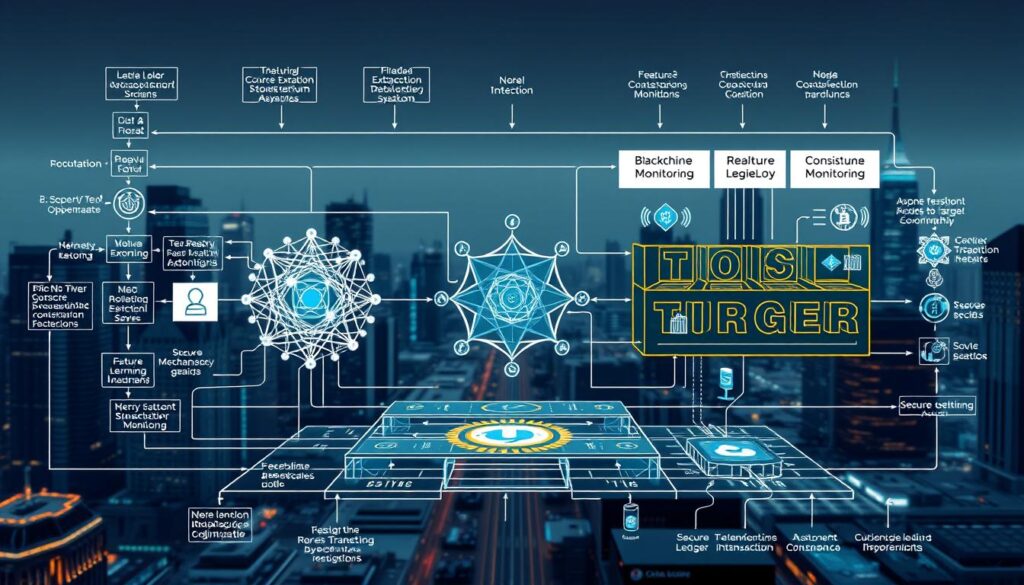Now Reading: Transparent Smart Contracts: How They Work and Why
- 01
Transparent Smart Contracts: How They Work and Why
Transparent Smart Contracts: How They Work and Why

Digital agreements are evolving faster than ever. At the heart of this shift are self-executing tools that automate processes without intermediaries. These systems run on blockchain networks, ensuring every action is visible and permanent. This eliminates disputes caused by hidden clauses or manual errors.
What sets these agreements apart? Their terms are automatically enforced through code. Once activated, they follow predefined rules exactly as written. This reduces delays and costs tied to traditional paperwork. Parties can verify outcomes in real time, creating accountability without third-party oversight.
Trust is built through openness. Every step—from initiation to completion—is recorded publicly. This approach minimizes fraud risks and ensures fairness. Since records can’t be altered retroactively, participants rely on accuracy from the start.
Adopting this technology requires planning. Terms must be precise before activation, as changes aren’t possible afterward. Industries like finance and supply chains already use these tools to streamline operations. The next sections will explore practical applications and implementation strategies.
Key Takeaways
- Self-executing agreements remove middlemen through automated blockchain processes
- All actions and terms are permanently visible to involved parties
- Immutability ensures agreements can’t be modified after activation
- Real-time verification reduces delays and builds accountability
- Precise preparation is critical before deployment
Introduction to the World of Smart Contracts
Modern agreements are undergoing a radical transformation through code-driven solutions. Unlike paper-based systems, these digital tools operate on decentralized networks where every action becomes part of an unchangeable record. This shift marks a new era for business interactions, powered by advancements in distributed ledger systems.
Setting the Stage for Blockchain Innovation
Code-based agreements work by automatically enforcing terms when preset conditions meet. Built on blockchain technology, they remove reliance on third parties like legal advisors. For example, a rental payment could trigger access to a digital property key without human intervention.
Traditional methods often involve delays from manual reviews or misplaced documents. Digital alternatives execute instantly, cutting administrative costs by up to 80% in some industries. Their immutable nature ensures neither party can alter terms after activation.
Key benefits include:
- Automated verification of compliance
- 24/7 operational capabilities
- Reduced risk of interpretation errors
Industries from healthcare to logistics now explore these systems to handle complex workflows. As adoption grows, so does the need for precise coding and thorough testing before deployment.
Understanding Transparent smart contracts
Automated agreements are redefining trust in digital partnerships. Built on blockchain systems, these tools ensure every participant sees the same terms simultaneously. This visibility creates a shared understanding that paper documents can’t match.

Key Concepts and Definitions
Code-driven agreements operate through three core principles:
- Immutability: Once activated, terms can’t be edited without consensus
- Self-execution: Actions trigger automatically when conditions meet
- Decentralized verification: Multiple nodes validate each step
Unlike traditional deals, all parties access real-time updates through the ledger. Changes require group approval, preventing unilateral adjustments. This framework builds accountability directly into transactions.
For instance, a supply chain agreement might release payments only after GPS confirms delivery. The rules apply equally to all participants, removing interpretation gaps. This precision makes disputes rare and resolutions faster.
How Transparent Smart Contracts Function on the Blockchain
Digital partnerships now operate through systems where visibility is built-in. These tools run on blockchain networks, creating a shared rulebook accessible to all participants. Every action follows predefined logic, making outcomes predictable and verifiable.
The Role of Decentralization and Immutability
Blockchain’s distributed architecture ensures no single entity controls the agreement. Changes require majority approval from network validators. This setup prevents unauthorized edits while maintaining a permanent history of all activities.
Key features include:
- Equal access to terms across all parties
- Automatic enforcement of coded rules
- Permanent records stored across multiple nodes
Self-Executing Agreements Explained
When specific conditions occur, the system triggers actions without manual input. For example, a shipping confirmation might release funds instantly. This automation reduces delays and human error.
Every step leaves a traceable mark on the ledger. Participants monitor progress in real time, creating accountability. Since terms are locked during deployment, disputes over interpretation become rare.
Transparency Advantages in Smart Contract Technology
Visibility in digital agreements reshapes how organizations collaborate. By making every term and action trackable, these systems create shared accountability among participants. This openness reduces disputes while building confidence in outcomes.

Enhanced Trust and Security in Transactions
Real-time tracking lets all parties monitor progress simultaneously. Suspicious patterns trigger alerts before issues escalate. For example, payment releases only occur when delivery sensors confirm location data matches the terms.
Three security benefits stand out:
- Fraud detection through multi-party validation
- Automatic compliance with predefined rules
- Encrypted records resistant to tampering
Eliminating Intermediaries for Streamlined Processes
Automation replaces manual oversight in code-based agreements. A shipping contract might self-verify customs clearance through port authority databases. This cuts approval wait times from days to minutes.
Small businesses gain equal access to robust deal structures without legal retainers. Reduced paperwork and faster execution let teams focus on growth rather than administration.
Implementation and Code Insights of Smart Contracts
Building functional blockchain agreements requires precise technical execution. Developers use languages like Solidity to create logic that runs on the Ethereum Virtual Machine (EVM). This code defines how agreements process inputs, validate conditions, and execute outcomes autonomously.
Exploring Solidity and On-Chain Code Execution
Solidity serves as the backbone for most blockchain-based agreements. Its syntax resembles JavaScript but includes unique features for handling cryptographic operations. A simple function in Solidity might verify payment releases or ownership transfers when specific criteria meet.
The ERC-20 standard illustrates how code standardization drives interoperability. This framework defines six core functions every token must include:
- Balances tracking
- Transfer approvals
- Supply limits
When deployed, Solidity code compiles into bytecode—a machine-readable format stored on-chain. While developers write human-friendly source code, the EVM only interacts with this optimized version. Bytecode’s complexity makes reverse-engineering challenging without specialized tools.
Successful implementation demands rigorous testing. Developers simulate scenarios using testnets before mainnet deployment. This process catches errors that could compromise security or functionality. On-chain execution then ensures all participants see identical results, maintaining system integrity.
Practical Use Cases and Applications on the Ethereum Blockchain

Financial markets are witnessing a silent revolution through tokenized assets. Over $200 million in securities like bonds and ETFs now operate on public ledgers. These digital versions of traditional instruments rely on code-based agreements to handle ownership transfers and compliance checks automatically.
Tokenized gold stands out as a prime example, hitting $1 billion in market value last year. Investors trade fractional ounces 24/7 using systems that mirror physical vault holdings. This approach eliminates storage fees while maintaining audit trails accessible to all participants.
Key sectors adopting these solutions include:
- Supply chains: Shipping contracts trigger payments when IoT sensors confirm delivery
- Healthcare: Patient data-sharing agreements enforce privacy rules across networks
- Real estate: Property deeds transfer instantly after automated title checks
The Ethereum network powers most implementations due to its mature infrastructure. Developers build custom logic using its native programming tools, creating tailored solutions for specific industries. A manufacturing firm might automate royalty payments using supply chain milestones tracked on-chain.
Emerging applications stretch beyond finance. Universities now issue verifiable digital diplomas through code-based systems. Each credential links to immutable records, reducing fraud risks for employers. As adoption grows, these tools reshape how organizations handle agreements at scale.
In-Depth Look at Smart Contract Upgrades Using Proxies
Blockchain systems require adaptable frameworks to evolve without disrupting users. Upgradeable architectures solve this challenge by separating logic from storage. Proxies act as intermediaries, directing interactions to the latest version while preserving historical data.
Transparent Proxies Explained and Their Benefits
Imagine a restaurant host who seats guests but doesn’t cook meals. Similarly, proxies manage requests without holding business logic. They store two critical details: where the current rules live (implementation address) and who controls updates (admin address).
This design offers three advantages:
- Continuous service: Users interact with one permanent address
- Risk reduction: Testing new code doesn’t affect live operations
- State preservation: User balances and settings remain intact during upgrades
Deployment and Upgrade Process Highlights
Developers first deploy the proxy with initial logic. When improvements are ready, they:
- Create a new contract with updated functions
- Verify compatibility with existing data structures
- Point the proxy’s implementation slot to the new address
This approach mirrors how decentralized systems maintain reliability while innovating. Each upgrade undergoes rigorous audits to prevent vulnerabilities. The admin retains control through multi-signature approvals, balancing agility with security.
Real-World Examples and Case Studies from Tokenized Bonds
Financial institutions are now testing blockchain’s potential through tangible experiments. Two landmark projects—Santander’s 2019 bond and the European Investment Bank’s 2021 issuance—show how code-driven systems reshape traditional finance. These case studies reveal contrasting approaches to transparency and control in digital agreements.
Santander’s Ethereum-Based Bond Trial
In September 2019, Santander launched a $20 million bond using the Ethereum blockchain. The one-year agreement offered quarterly 1.98% payouts but closed early after three months. While it proved blockchain’s speed for settlements, the bank kept its code private—limiting third-party verification.
EIB’s Permissioned Digital Bond Framework
The European Investment Bank took a different path in April 2021. Its 100 million euro digital bond split responsibilities across three roles: Issuer, Registrar, and Settler. Unlike Santander, the EIB published its contract code on Etherscan, allowing public audits. This open implementation strengthened trust in its zero-coupon structure.
These examples highlight critical trade-offs. While Santander prioritized speed, the EIB’s transparent model offers a blueprint for secure, multi-party systems. For more successful implementations, explore how industries balance innovation with accountability in blockchain solutions.
FAQ
How do blockchain-based agreements ensure trust without intermediaries?
These systems use decentralized networks to validate actions automatically. Every transaction is recorded on a public ledger, visible to all participants. This eliminates the need for third-party oversight while maintaining accuracy through cryptographic verification.
What makes Ethereum a preferred platform for decentralized agreements?
Ethereum’s ecosystem supports Turing-complete programming languages like Solidity, enabling complex logic execution. Its robust developer community and established standards (like ERC-20) provide a reliable foundation for building customizable, interoperable solutions.
Can existing financial systems integrate with blockchain-executed deals?
Yes. Institutions like Santander and the European Investment Bank have successfully tokenized bonds using blockchain frameworks. These implementations maintain regulatory compliance while improving settlement speed and audit capabilities through on-chain data trails.
How does Solidity enhance code execution in decentralized apps?
Solidity’s syntax allows developers to define precise conditions for automated processes. When deployed, the bytecode runs across Ethereum nodes, ensuring identical outcomes worldwide. Tools like Remix IDE simplify testing and debugging before mainnet deployment.
Are there risks in automating processes via blockchain?
While immutability prevents tampering, errors in initial coding can lead to irreversible outcomes. Audits by firms like OpenZeppelin and formal verification methods mitigate this risk. Transparent proxies also enable controlled upgrades without compromising historical data integrity.
What are transparent proxies in decentralized system upgrades?
This upgrade pattern separates logic storage from execution addresses. Users interact with a proxy address that routes requests to the latest implementation. Platforms like Uniswap use this method to introduce new features while preserving existing user interactions and asset histories.
















